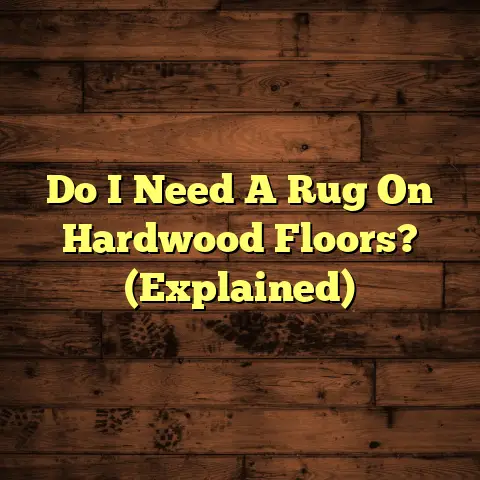Best Flooring For Uneven Concrete? (3 Options Now!)
Imagine stepping into a cozy, sunlit living room where the warmth of a gentle afternoon breeze mingles with the soft sounds of laughter and clinking glasses.
Friends gather around a beautifully crafted coffee table, the rich aroma of freshly brewed coffee wafting through the air.
As you take a seat on the plush sofa, your eyes wander to the floor beneath you.
The smooth, inviting surface complements the room’s aesthetic, creating an ambiance of comfort and sophistication.
But what if that floor was marred by uneven concrete?
Instead of a seamless transition between spaces, you would find yourself navigating a patchwork of bumps and dips, detracting from the overall enjoyment of your home.
That’s a real buzzkill, right?
In this article, I’ll explore the best flooring options for those dealing with uneven concrete surfaces.
Whether you’re renovating an old space, transforming a basement, or simply looking to upgrade, the right flooring can make a world of difference.
I’ll delve into three top choices that not only provide a solution to the unevenness but also enhance the overall look and feel of your environment.
Let’s get started!
1. Introduction
Uneven concrete. It’s the bane of many a homeowner’s existence.
It’s not just an aesthetic problem; it can affect the functionality and safety of your space.
Choosing the right flooring is crucial, not only for looks but also for long-term durability and comfort.
Think of it this way: your floor is the foundation of your room’s entire vibe.
Nail the floor, nail the room!
The Challenge of Uneven Concrete
So, what’s the big deal with uneven concrete?
Well, for starters, it makes installing most types of flooring a real pain.
Try laying tile on a surface that looks like the Himalayas, and you’ll quickly understand.
But it’s more than just a hassle.
Uneven floors can lead to:
- Tripping hazards: Nobody wants unexpected tumbles.
- Damaged flooring: Stress points can cause cracks and breaks.
- Uneven furniture: That wobbly table? Yeah, it’s the floor.
- Reduced home value: Let’s be honest, it’s a turn-off for buyers.
Aesthetics and Functionality
The right flooring choice needs to tackle both the aesthetic and functional aspects of your space.
You want something that looks great, feels comfortable underfoot, and can stand up to daily wear and tear.
Plus, it needs to handle that uneven concrete without looking like a quick fix.
It’s a balancing act, but definitely achievable!
2. Understanding Uneven Concrete
Before diving into flooring options, let’s get a handle on why concrete becomes uneven in the first place.
It’s not always as simple as a bad pour during construction.
Causes of Uneven Concrete
Several factors can contribute to uneven concrete:
-
Settling: Over time, the ground beneath your foundation shifts, causing the concrete to settle unevenly. This is super common in areas with expansive clay soils.
-
Moisture: Water is concrete’s enemy. Excessive moisture can lead to expansion, contraction, and ultimately, cracking and unevenness. Think leaky pipes or poor drainage.
-
Poor Installation: A rushed or improperly executed concrete pour can result in uneven surfaces from the get-go. Cutting corners never pays off, trust me.
-
Tree Roots: Those sneaky roots can wreak havoc on foundations, pushing and lifting concrete slabs.
-
Seismic Activity: Earthquakes, even minor ones, can cause shifts and cracks in concrete.
Impact on Flooring Choices and Home Value
Uneven concrete significantly limits your flooring choices.
Rigid materials like ceramic tile or hardwood are tough to install and prone to cracking if the subfloor isn’t perfectly level.
That’s why flexibility is key.
Beyond aesthetics, an uneven floor can impact your home’s value.
Potential buyers see it as a red flag, signaling potential structural issues.
Addressing the problem with the right flooring can increase your home’s appeal and value.
3. Option 1: Luxury Vinyl Flooring
Let’s talk luxury vinyl flooring (LVF). This stuff is a game-changer for uneven concrete.
I’ve used it in countless projects, and it consistently delivers fantastic results.
What is Luxury Vinyl Flooring?
Luxury vinyl flooring is a synthetic flooring option designed to mimic the look of natural materials like wood, stone, or tile.
It’s typically composed of several layers:
- Wear Layer: This top layer protects against scratches, stains, and wear. The thicker the wear layer, the more durable the flooring.
- Print Layer: This layer provides the realistic design and appearance of the flooring.
- Core Layer: This is the main structural component, usually made of PVC or a composite material.
- Backing Layer: This bottom layer provides stability and cushioning.
LVF comes in two main forms:
- Luxury Vinyl Planks (LVP): Designed to look like hardwood planks.
- Luxury Vinyl Tiles (LVT): Designed to look like ceramic tile or stone.
Conforming to Uneven Surfaces
One of the biggest advantages of LVF is its flexibility.
Unlike rigid flooring options, LVF can conform to minor imperfections in the subfloor without cracking or warping.
Think of it as a forgiving friend.
This is especially true for thicker LVF options, which have a bit more give.
A good underlayment can also help bridge small gaps and provide additional cushioning.
Styles and Colors
LVF offers an incredible range of styles and colors.
You can find options that perfectly mimic the look of:
- Hardwood: From rustic oak to sleek maple, the options are endless.
- Stone: Replicate the look of marble, slate, or travertine without the high cost and maintenance.
- Tile: Achieve the look of ceramic or porcelain tile with the added comfort and warmth of vinyl.
This versatility makes LVF a popular choice for homeowners looking to achieve a specific aesthetic without breaking the bank.
Case Studies and Testimonials
I remember one project where a client had a seriously uneven basement floor.
Traditional tile was out of the question.
We installed a high-quality LVF with a wood-look finish, and the transformation was incredible.
The floor looked smooth and even, and the client was thrilled with the result.
Another homeowner told me, “I was worried about the uneven spots, but the luxury vinyl just glided right over them. It looks amazing, and it’s so easy to clean!”
Stories like that make my day!
4. Option 2: Laminate Flooring
Next up, let’s explore laminate flooring.
It’s another great option for dealing with uneven concrete, especially when paired with the right underlayment.
What is Laminate Flooring?
Laminate flooring is a multi-layered synthetic flooring product fused together through a lamination process.
It typically consists of:
- Wear Layer: A transparent top layer that protects against scratches, stains, and fading.
- Decorative Layer: A high-resolution photographic image that mimics the look of wood, stone, or tile.
- Core Layer: A dense fiberboard core (usually HDF – High-Density Fiberboard) that provides stability and resistance to impact.
- Backing Layer: A moisture-resistant layer that protects the core from water damage.
Stability with Underlayment
Laminate flooring is more rigid than LVF, so it’s crucial to use a good underlayment when installing it over uneven concrete.
The underlayment acts as a cushion, absorbing minor imperfections and providing a stable surface for the laminate planks.
Look for underlayments specifically designed for uneven subfloors.
These often have a higher density and better sound insulation properties.
Aesthetic Appeal
Laminate flooring is known for its realistic appearance.
Thanks to advances in printing technology, it can closely resemble:
- Hardwood: With realistic wood grain patterns and textures.
- Tile: Including the look of grout lines and varying tile sizes.
- Stone: Capturing the natural variations and colors of stone.
This makes it a versatile choice for any room in your home.
Successful Installations
I’ve seen laminate flooring completely transform spaces with uneven floors.
One project involved an old farmhouse with a seriously sloping kitchen floor.
We used a self-leveling compound to address the worst areas and then installed a thick underlayment before laying the laminate.
The result was a beautiful, level floor that looked like real hardwood.
The homeowner was thrilled with the updated look and the added stability.
5. Option 3: Carpet Tiles
Now, let’s talk about carpet tiles.
These modular squares offer a unique solution for uneven concrete, providing flexibility and comfort.
What are Carpet Tiles?
Carpet tiles, also known as carpet squares, are individual pieces of carpet that can be installed in a variety of patterns and configurations.
They typically have a backing made of:
- Vinyl: For durability and moisture resistance.
- Bitumen: A cost-effective option.
- Fiberglass: For added stability.
Carpet tiles come in a wide range of colors, patterns, and textures, allowing for endless design possibilities.
Practical Solution for Uneven Surfaces
Carpet tiles are incredibly forgiving when it comes to uneven surfaces.
Because they’re installed individually, they can conform to minor dips and bumps without creating a noticeable problem.
You can also strategically place tiles to minimize the impact of uneven areas.
For example, you might use thicker tiles in areas with significant dips or install a layer of padding underneath certain tiles to level them out.
Comfort and Warmth
Carpet tiles bring a level of comfort and warmth to a space that other flooring options can’t match.
They’re soft underfoot, making them ideal for:
- Living areas: Creating a cozy and inviting atmosphere.
- Bedrooms: Providing a warm and comfortable surface to step onto.
- Basements: Adding insulation and reducing noise.
Homeowner Stories
I once helped a homeowner transform their cold, concrete basement into a cozy family room using carpet tiles.
The floor was notoriously uneven, but the carpet tiles handled it like a champ.
The homeowner loved the added warmth and comfort, and the kids appreciated having a soft place to play.
Another client used carpet tiles to create a unique and stylish office space.
They mixed and matched different colors and patterns to create a custom design that perfectly reflected their personality.
6. Comparison of Options
Alright, let’s break down these three flooring options and see how they stack up against each other.
Here’s a comparative analysis based on cost, installation, maintenance, and durability:
| Feature | Luxury Vinyl Flooring | Laminate Flooring | Carpet Tiles |
|---|---|---|---|
| Cost | Mid-Range | Mid-Range | Low to Mid-Range |
| Installation | Easy | Moderate | Easy |
| Maintenance | Easy | Easy | Moderate |
| Durability | High | Moderate | Moderate |
| Water Resistance | High | Moderate | Low |
| Comfort | Moderate | Moderate | High |
| Unevenness | Excellent | Good (with underlayment) | Excellent |
Cost: All three options fall within a reasonable price range, but carpet tiles generally offer the most budget-friendly solution.
Installation: LVF and carpet tiles are relatively easy to install, making them great DIY options. Laminate requires a bit more skill and precision.
Maintenance: LVF and laminate are super easy to clean – just sweep or mop. Carpet tiles require regular vacuuming and occasional spot cleaning.
Durability: LVF is the most durable of the three, standing up well to scratches, stains, and heavy foot traffic.
Water Resistance: LVF is highly water-resistant, making it a great choice for bathrooms and kitchens. Laminate is moderately water-resistant, while carpet tiles are not ideal for wet areas.
Comfort: Carpet tiles win hands down when it comes to comfort and warmth.
Handling Unevenness: Both LVF and carpet tiles excel at conforming to uneven surfaces. Laminate can work well with the right underlayment.
7. Conclusion
So, what’s the best flooring for uneven concrete?
It really depends on your specific needs, budget, and aesthetic preferences.
- Luxury Vinyl Flooring: A versatile and durable option that can handle unevenness with ease.
- Laminate Flooring: A cost-effective choice that offers a realistic look with the right underlayment.
- Carpet Tiles: A comfortable and forgiving option that’s perfect for adding warmth to any space.
The key takeaway is this: don’t let uneven concrete hold you back from creating the beautiful and functional space you’ve always dreamed of.
With the right flooring choice and a little bit of planning, even the most challenging surfaces can be transformed into something amazing.
Happy flooring!





